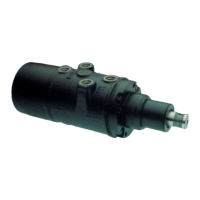Bulletin 2751-001-M1/USA
Service Manual
HGA Hydraguide™
Hydraulics
Parker Hannifin Corporation
Hydraulic Pump/Motor Division
Greeneville, Tennessee
18
Inspection and Replacement
Visually inspect all parts and replace those parts
which are not in good condition. The following finished
surfaces should be inspected for abnormal wear,
scoring or damage.
1. Housing (25) bore and ends.
2. Valve spool (22) outside diameter. Some burnish-
ing due to use may be observed.
3. Valve spool (22) control edges.
4. Valve spool (22) splines.
5. Input shaft (16) seal area. Check for rust, pitting
and excessive wear. Light circumferential polishing
due to seal contact may be observed.
6. Input shaft (16) helical groove. Note the contact
pattern created by the actuator ball (23). Surface
should be free from pits chipping or surface break
down.
7. Thrust bearing (12) and thrust washers (11) and
(13). Inspect for pitting of rolls and faces of thrust
washers.
8. Drive link (30) pin slot. Width of slot must not
exceed .001 inch difference at any point in its
length.
9. Drive link (30) teeth.
10. Torsion bar and needle roller assembly (20).
Difference in diameter of needle roller (21) should
not exceed .001.
The following parts may show a polish pattern due to
the rotor action and the circular motion of the commu-
tator. The sides of these components are ground and
lapped and should be free from nicks, burrs and
scoring.
1. Spacer (29).
2. Manifold (32).
3. Rotor (31).
4. Commutator (34) and Commutator Ring (33).
Note: Thickness difference between commuta-
tor and commutator ring (33) shall not exceed
.002 inch.
5. End cover and pin assembly (38).
Note: The rotor set (31) requires special attention
in handling to avoid nicks and scratching. It is
recommended that the rotor (31B), stator (31A),
vanes (31D) and springs (31C) be checked in the
assembled condition. To inspect the rotor set,
place the assembly face down on the lapped face
of the end cover (38) and check for freedom of
rotor rotation within the stator. The action of the
spring loaded vanes may be observed during
rotation. The vanes should move freely in their
slots, without bind, due to the forces of the
springs. (See Figure HGA-15).
Using a feeler gage, check the rotor (31B) to the stator
(31A) clearance as shown in figure HGA-16. If there is
more than a .007 inch clearance, the rotor set (31)
must be replaced. Note: This applies to rotor sets
with and without vanes.
Carefully lift the rotor set assembly (31) from the end
cover (38) and measure the thickness of the rotor
(31B) and stator (31A). Thickness difference between
the rotor and stator shall not exceed .003 inch.
The internal splines in the rotor should not allow
abnormal wear or damage.
Figure HGA-15
Figure HGA-16

